Content
- 1 Most popular varieties
- 2 Video tips for growing mulberry
- 3 Varieties
- 4 Description
- 5 Mulberry varieties
- 6 Weeping mulberry
- 7 Landing
- 8 Agrotechnics
- 9 Pruning
- 10 Getting seed
- 11 Seed reproduction
- 12 Vaccinations on frost-resistant stock
- 13 Propagation by green cuttings
- 14 Diseases and pests
- 15 Features of harvesting
- 16 Useful properties of white mulberry
- 17 Varieties
- 18 Video "Features of growing mulberry"
- 19 White varieties
- 20 Black varieties
- 21 Large varieties
- 22 Decorative varieties
- 23 Video "Features of a mulberry tree"
Mulberry (mulberry tree) is an evergreen, tall plant that grows in regions with warm climates. The leaves of this tree serve as food for silkworms that produce natural silk threads. The fruits are famous for their valuable medicinal properties. In the East, the mulberry tree is called the king-tree, and the old people are fed mulberry trees in order to prolong their life.
Mulberry fruits contain organic acids, fructose, carotene, calcium, magnesium, phosphorus, potassium, vitamins C, K, PP, group B. Antioxidants that are part of the composition prevent the aging of the body, improve the condition of the skin and hair. Mulberries are used in folk medicine to treat bronchitis, pneumonia, tonsillitis, hypertension, tonsillitis and other diseases.
Most popular varieties
As for the classification, it is very confusing.
The Mulberry family includes 200 species of trees, and only a little more than 15 of them are generally recognized.
There are 2 main forms of mulberry - black and white, which are divided into varieties. Let's get acquainted with the most remarkable representatives of a large family.
White honey
One of the most famous varieties obtained by domestic breeders. Bred by crossing several types of white mulberry. The tree is short. The crown of the pyramidal shape is rather thick. Fruits are elongated white drupes up to 3 cm long. They attract with an extraordinary taste - sweet, with a honey flavor. Berries are soft and require extra care during transportation. The variety has a consistently good yield and withstands low temperatures.
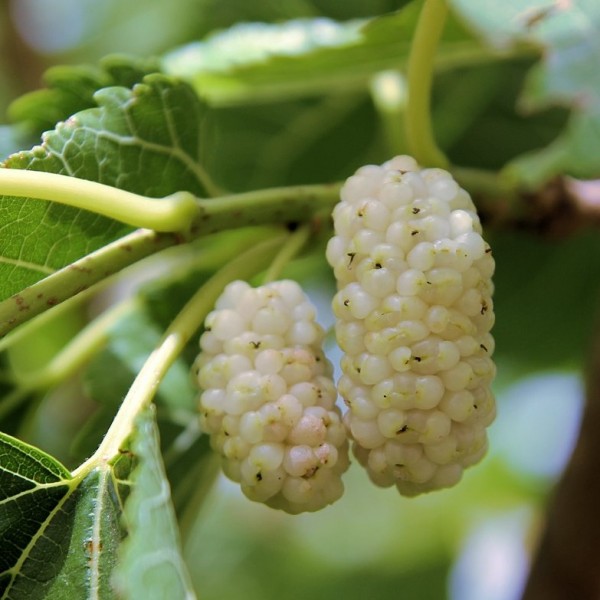
Smolensk pink
A great option for beginner gardeners.
The variety is easily adaptable to the environment and easy to care for. Differs in good frost resistance. Begins to bear fruit in the first year after planting.
Fruits are medium in size, pink or red in color. Fragrant and sweet. The beautiful shape of the leaves allows trees to be used as a spectacular decoration of the land.

Fruit-1
An early ripe variety that gives large and juicy fruits. Harvesting can begin in June. The main advantages are long-term fruiting and bright taste. The berries are sweet with a pleasant sourness. The mulberry tree is of a dense consistency; it does not wrinkle during transportation. A distinctive feature is that white seedlings turn pink in rainy weather. Do not be afraid - this is normal.
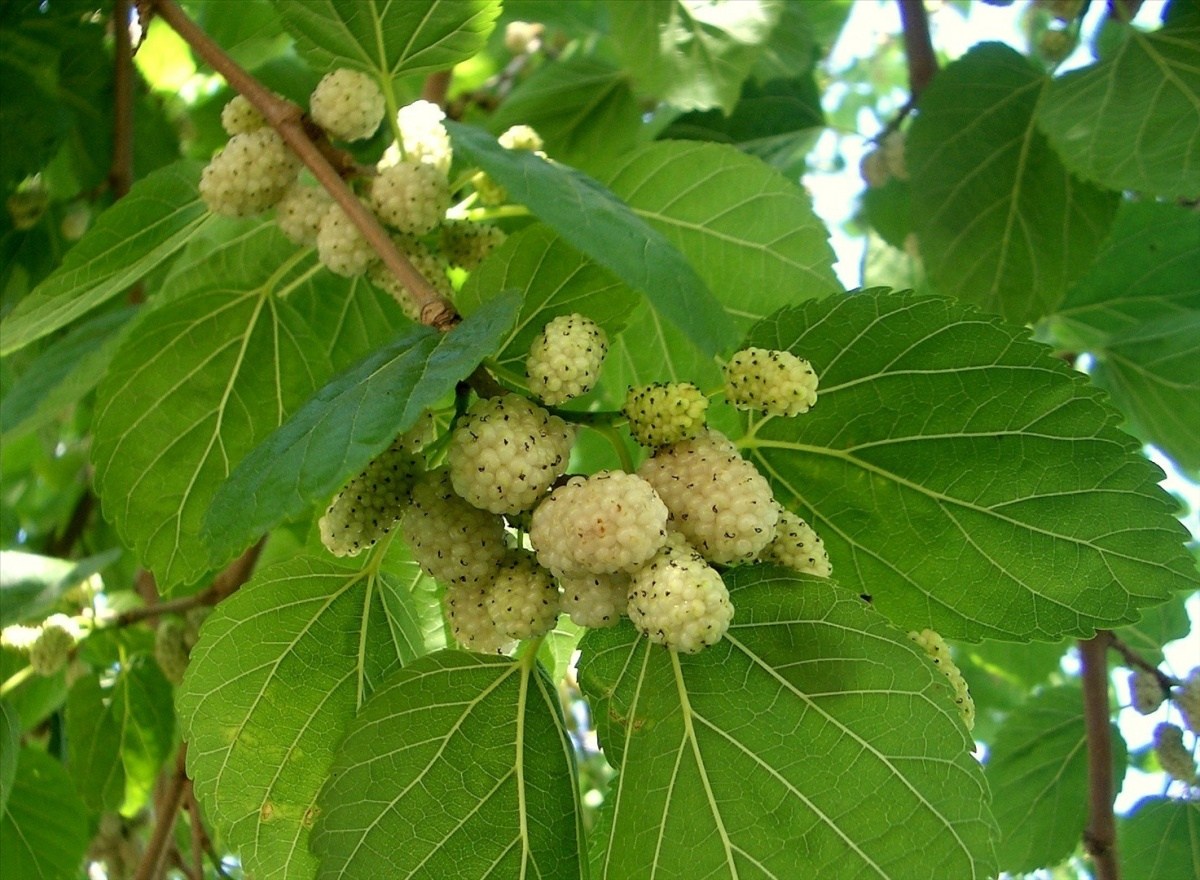
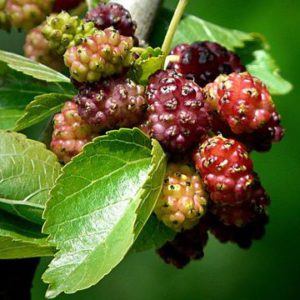 Merezhevo
Merezhevo
If, when choosing a suitable variety for growing, your goal is taste, then pay attention to Merezhevo. The hybrid obtained as a result of grafting white mulberry has many undeniable advantages. Fruiting lasts 1 month. Fruits are large, attractive pinkish-cream color. The taste is sugary sweet. However, there were some drawbacks. The berries crumble quickly, do not tolerate transportation well and are stored for a short time.
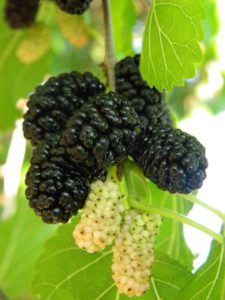 Fruit-4
Fruit-4
Good productivity is hidden behind the short growth and compact size of the tree. The fruiting period is long, the yield is good. Fruits are large (4 cm), color is black.The taste is sweet, with light refreshing notes. The variety is resistant to low temperatures and is excellent for commercial purposes. The mulberry tree does not lose its original characteristics during transportation.
Black Baroness
The variety fully lives up to its original name. Obtained as a result of experiments of domestic breeders. Fruits are large (4 cm), deep black. Fragrant and very sweet. Ripen in July. Stored - 12 hours. Yield indicators are also at the "height" - one tree gives up to 100 kg. The Black Baroness easily tolerates temperatures as low as -30 degrees. Adapts to any environment if necessary.
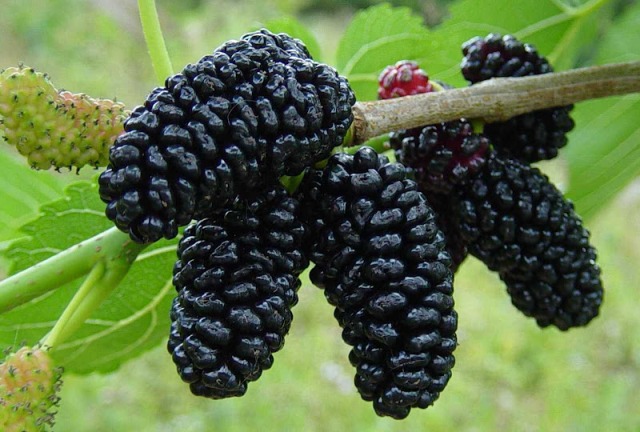
Shelley
A variety familiar to many gardeners. It is characterized by high decorative effect. Produces large fruits (5.5 cm). Begins to bear fruit at the end of June. The berries are long, dark, with a characteristic shine. The taste is dessert.
The dense consistency makes it possible to transport large quantities without loss.
Those who want to grow mulberry trees for the purpose of resale should choose this particular variety.
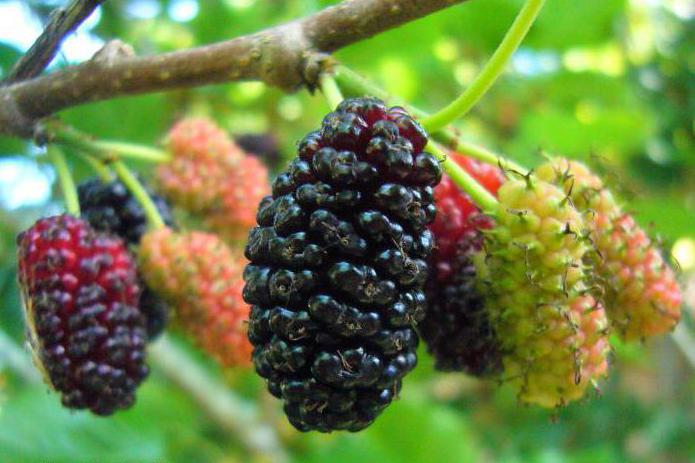
Shelley mulberry
Black Prince
Another priceless piece. It seems to be made up of only merits. Easy to care for, resistant to drought, frost and disease. It is appreciated for the beauty of large and glossy berries, reaching a length of 5 cm. Color - black. The taste is unusual, honey. It is noteworthy that the mulberry tree is juicy, but at the same time it does not wrinkle during transportation and is stored for a long time.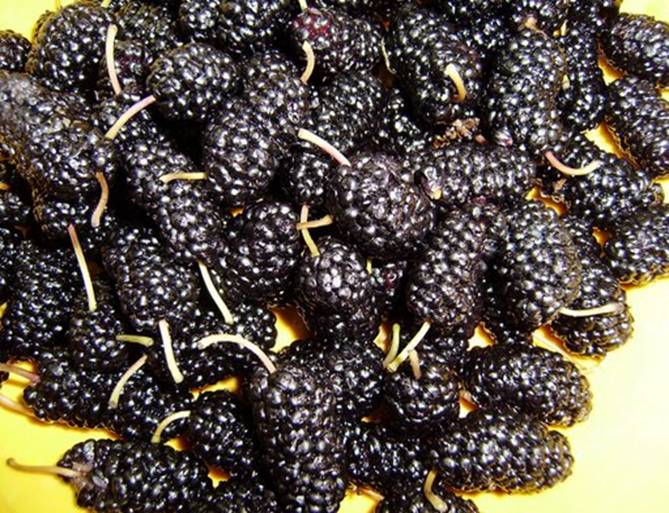
Hartut
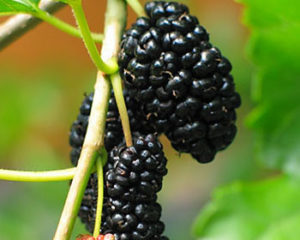 Fans of mulberry wine should plant this variety in their country house. Begins to bear fruit in the 3rd year of life. Yields are high and stable. The berries are large (5.5 cm), black. The thick juice obtained from them tastes like Cahors. The variety is actively used in winemaking and cooking. Easy to grow and disease resistant.
Fans of mulberry wine should plant this variety in their country house. Begins to bear fruit in the 3rd year of life. Yields are high and stable. The berries are large (5.5 cm), black. The thick juice obtained from them tastes like Cahors. The variety is actively used in winemaking and cooking. Easy to grow and disease resistant.
Ukrainian-6
It is appreciated for its high decorativeness and excellent taste. Fruiting begins in June. Fruits are elongated, large (4 cm). Color - matte black. The taste is sweet. The tree tolerates frosts down to -30 degrees without consequences. During transportation, the berries do not lose their original appearance. Stored - more than 2 weeks.
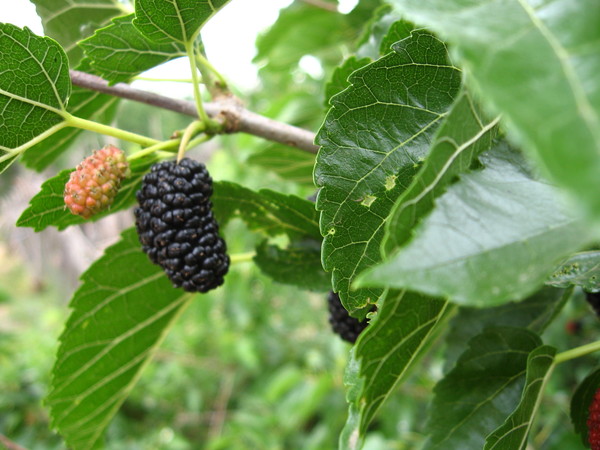
Above are the varieties intended for human consumption. However, there are many decorative varieties designed to embellish the environment. These include weeping mulberry, golden, pyramidal, Tatar, spherical. There are varieties that can be grown in small containers or pots. That is, the choice of a variety will directly depend on what goals you are pursuing.
Video tips for growing mulberry
Various fruit trees grow in the garden. These are apple, pear, cherry, plum and sweet cherry. However, the mulberry tree is quite rare in it. But in the recent past, it was very popular and affordable. The older generation of gardeners has a lot to say about the beneficial plant that has now become exotic.
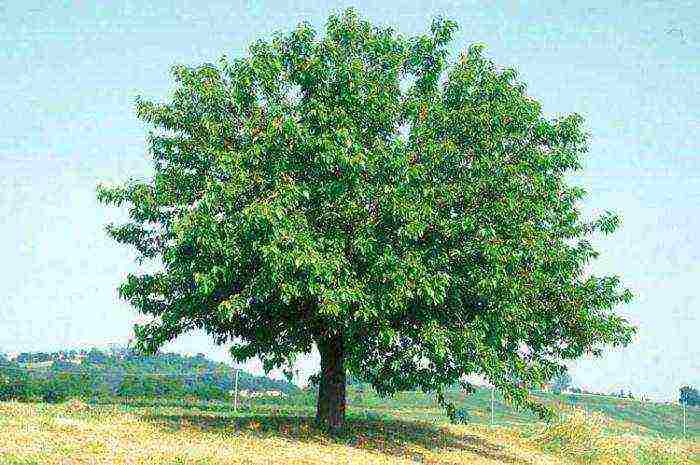
Varieties
An amazing long-liver originally from China. It has long been cultivated as a fodder crop. The leaves of the tree served as food for the silkworm - the producer of raw materials for the manufacture of unique fabrics. Gardeners grow the Morus mulberry tree not for silk production, but as an ornamental and fruit crop. The genus consists of twenty-four species. Of these, white and black mulberries are fruitful, a distinctive characteristic of which is the color of the bark of an adult plant. Many gardeners mistakenly believed that mulberries are distinguished by the color of their berries. However, this is not at all the case.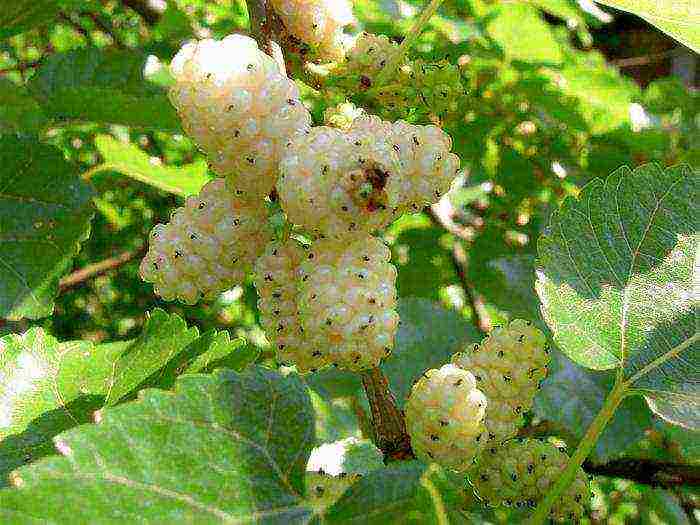
White mulberry has a light bark color. But the berries can be white, cream, pink, purple or completely black. The numerous genus Morus is represented by dioecious and, more rarely, monoecious trees. Most are thermophilic plants that can be grown in southern areas.Only the white mulberry in the middle lane does not freeze, grows well and bears fruit.
Description
Not every fruit plant can boast of its longevity. Within two hundred or even three hundred years, a mulberry will give birth, over time without changing its qualities. The spreading tree reaches a height of twenty to thirty-five meters. Often it is formed in the form of a two- or three-meter bush. The bark is light. The spherical crown is densely covered with oval foliage.
Coliform inflorescences of a mulberry tree are small. They are light green in color. A dioecious or, less commonly, a monoecious plant is wind-pollinated. Drupe fruits are formed in the form of small fruit fruits. They have a pleasant sweetish taste. Depending on the variety, the berries can be colored in different colors. White mulberry ripens from May to July. She bears fruit in the fifth year after planting. The yield is high. The berry picking period is somewhat extended due to uncomfortable ripening. They are not transportable and poorly stored, used immediately after removal.
This mulberry tree is winter-hardy and drought-resistant. These qualities characterize the plant as quite hardy and unpretentious. It is suitable for areas with any type of soil. In addition to these advantages, the mulberry tree is a medicinal plant. The fruits are high in vitamins. In addition, they contain a flavonoid, morin, carotene, fatty acids, and iron salts. Not only berries have medicinal properties. The bark and leaves of the tree are also used medicinally.
Mulberry varieties
White mulberry can act as a fodder, fruit and ornamental crop. They are presented in various varieties with individual characteristics.
So, among the fruitful varieties, white honey mulberry is quite attractive. It is characterized by relative frost resistance and unpretentiousness, resistance to diseases. A tall, deciduous tree has a wide crown. Simple oval leaves are light green in color. Inflorescences are spike-shaped. The juicy fruits are white in color.
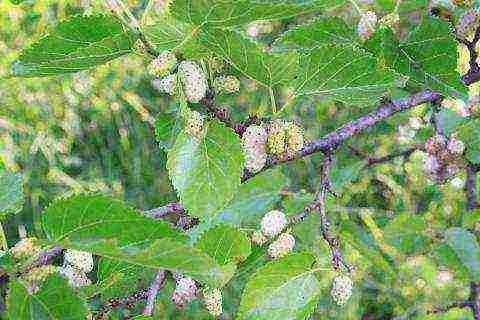
Good taste. Long-term harvesting begins at the end of June. Uneven ripening of fruits lasts until early August. Fresh berries are stored for no more than six hours. They practically do not tolerate transportation.
White mulberry varieties Baronessa is a deciduous dioecious plant. Dense, well-leafy crown has a spherical shape. Flowers are dioecious. They are light in color and form a spike-shaped inflorescence. Large berries, which are 3.5 cm in size and 1.5 cm in diameter, are densely colored black. The aromatic complex drupe has a sweet, pleasant taste. Unlike the previous variety, the fruits are relatively transportable. The shelf life is twelve hours. High-yielding variety.
The berry picking period is June-July. This mulberry tree is an unpretentious plant with high frost-resistant indicators. Mulberry in central Russia winters well.
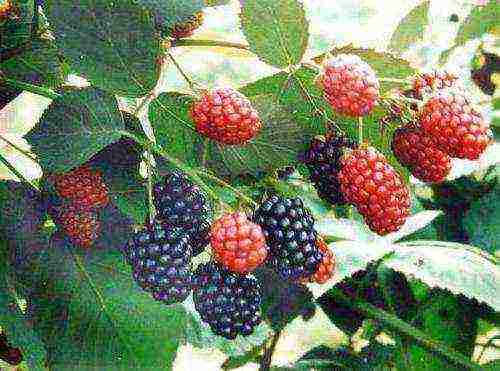
Blackberry Mulberry is a tall, spreading tree with a pyramidal crown. Large fruits reach three centimeters. Black berries are very juicy. The taste is excellent. The slightly acidic taste does not spoil the berries. This variety is less winter-hardy than the Baroness. In winter, the twigs can freeze slightly. An unpretentious plant has a high yield. Fruit ripening occurs at the beginning of July.
In addition to fruit species, there are more than four hundred decorative forms. Mulberry varieties differ in the shape and color of the crown and foliage. These are spectacular plants that are used in landscape design. Trees and shrubs, alleys and hedges, which include mulberry trees, are wonderful. Their openwork crown goes well with evergreens.
White weeping mulberry
A low-growing tree or shrub reaches a height and width of up to three meters. It has a very decorative appearance.The elongated branches of the mulberry tree hang down. This form is irreplaceable in landscape design and will be a decoration of any garden. 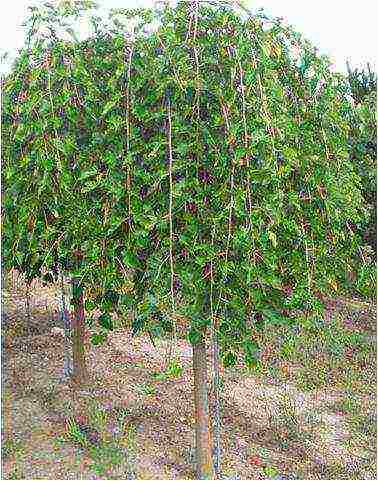
Large, dark green leaves, which can be from eight to twenty centimeters long, are heart-shaped. In autumn they turn yellow. The flowering period is from May to June. Mulberry bears fruit with few fruits. They are edible and have a pleasant sweet taste.
In addition, there are spherical, dissected-leaved, Tatar and golden forms of white mulberry. Each of them has its own advantages and is widely used for single or group landings.
Landing
Often summer residents hesitate to plant mulberries, since space is limited in a small area. "Is my garden fit for trendy exoticism?" - such a question arises among gardeners when choosing one or another variety of a long-lived giant.
Growing mulberries provides several ways to form a plant that will limit the height. A tall, powerful, spreading tree requires a larger area of nutrition. Mulberry planting is carried out according to the scheme of 5 x 6 m. When limiting the height of the mulberry tree and growing in the form of a bush, the scheme is different and is 2 x 3 m. White mulberry is unpretentious. It grows equally well both in unfavorable urban conditions and in suburban summer cottages. The corner of the garden in which the mulberry will grow should be well lit. Planting and caring for mulberry trees follows the generally accepted rules for fruit trees. Saplings are planted in early spring. The landing site should be such as not to damage the root system. For better rooting, a mixture of humus and sand is added to the hole. Water the planting hole abundantly and sprinkle it with soil. Around the trunk of the seedling, the soil is mulched with peat. In the autumn, planting is carried out one and a half months before the onset of frost.
Agrotechnics
Care consists of removing weeds, loosening the soil and regular watering. It is especially important to keep an eye on newly planted plants. The presence of weeds that are detrimental to plants is not allowed in the near-trunk circles. Regular weeding and mulching with humus or peat will help them grow normally and quickly. Organic and mineral fertilizers are applied during the summer season. This agronomic technique is very important for the normal development of mulberries and good yields. Fertilization is carried out during bud break. One square meter requires fifty grams of nitrophosphate. After fertilization, the soil is watered vigorously. Watering is stopped in early July. During this period, feeding should also not be carried out. Enhanced nutrition will promote the growth of young shoots, which will freeze out in winter.
Pruning

So that the tree does not grow tall and looks well-groomed, its crown is formed, limiting the growth to three meters. In addition, last year's young growths may freeze slightly in winter. They need to be removed. Mulberry pruning has no individual characteristics. They carry out sanitary and anti-aging techniques, which they perform, following the generally accepted recommendations for fruit trees and shrubs. The mulberry tree tolerates a haircut very well. This reception should be regular. Thinning of the crown is carried out annually. In this case, diseased, damaged and weak branches are subject to removal. Crossed shoots are also cut off.
Getting seed
White mulberry ripens in summer. Ripe fruits are suitable for obtaining seeds. After harvesting, some of the berries are left in the sun. They are slightly overripe. Then they are placed in a container for several days.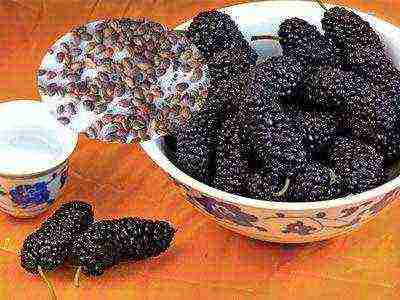
Juicy fruits should turn sour. Then they are ground in water. Full-weight seeds sink to the bottom of the container. This mass is rubbed through a fine sieve. The resulting seeds are dried. They must be used throughout the year.They quickly lose their germination.
Seed reproduction
Several methods are used to obtain young plants. Seed propagation is possible. This method is started with stratification. The seeds are kept at a temperature of zero or five degrees for a month. A greenhouse is pre-prepared. In early April, mulberry will be sown in it. Reproduction in this way allows you to have forty-centimeter seedlings already in the autumn.
Vaccinations on frost-resistant stock
In order to preserve the maternal traits of a particular strain, grafting will be more effective. This method is more complicated. It requires careful selection of breeding material. Winter mulberry grafting is often used. Young plants of frost-resistant mulberry varieties grown from seeds are used as a stock. They are dug up and stored in wet sawdust. The storage temperature should be zero degrees. Grafts are also stored in moist sawdust. After grafting, the planting material is placed in boxes and kept at a temperature of twenty-five degrees. After that, they are stored in moist sawdust at zero temperature until spring.
Mulberry grafting in the spring is carried out on last year's rootstocks. This event falls on the period before bud break. Cuttings cut in the fall are used. They are stored throughout the winter in wet sawdust at zero temperature.
You can also vaccinate in the summer. For this, the blanks of the current year are used.
Propagation by green cuttings
Planting material is harvested in the second decade of June. Green shoots are suitable, the length of which is at least fifteen centimeters. They are cut from non-lignified branches. The blanks are processed by removing the lower leaves and shortening the upper ones by half. Before rooting, the cuttings are kept for six hours in an aqueous solution of heteroauxin. 
Or they are placed in a mixture of sand and peat, which is moistened with this solution. Green cuttings are rooted indoors. The main condition is high air humidity. To create a greenhouse effect, they cover with plastic wrap.
Diseases and pests
Like any culture, white mulberry is susceptible to infection. It can be affected by diseases such as bacteriosis, powdery mildew and root rot.
In the spring, prophylactic spraying of the tree with special preparations is carried out.
There are also many pests in the mulberry tree. Beetles, bear, mulberry barbel, wireworm and spider mite damage various parts of the plant. Mechanical and chemical methods are used to combat them. In the autumn, the fallen leaves must be removed and burned.
Features of harvesting
White mulberry is characterized by an extended fruiting period. The berries ripen unevenly. On the one hand, this is good. For a longer period, the mulberry tree will delight with ripe juicy fruits. However, ripe fruits should be removed in a timely manner. Almost all varieties of white mulberry are poorly stored. They are not transportable. If there is a delay in picking, the berries crumble, which leads to their spoilage. After removal, the fruits are immediately processed or consumed fresh.
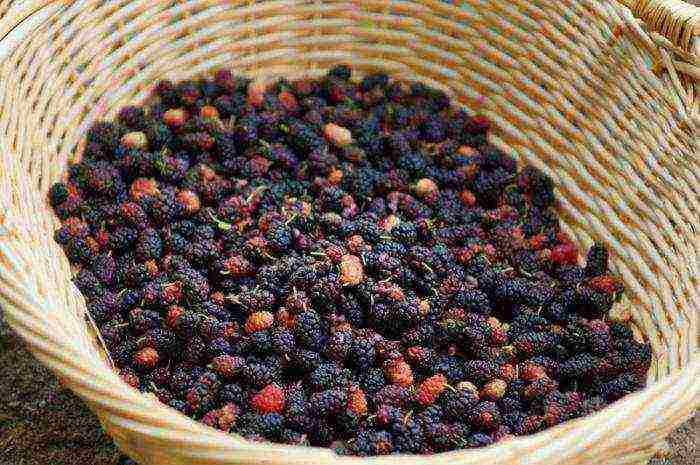
Useful properties of white mulberry
The medicinal properties of the mulberry tree have been known for a long time. The use of fresh berries helps to improve the general condition of a person. White mulberry helps to normalize the nervous system. It is included in weight loss diets. Low-calorie berry perfectly normalizes metabolism. In addition, the plant cleanses the intestines and promotes the elimination of toxins. Mulberries are most often consumed fresh. It is also cooked. It is suitable for future workpieces. You can make juices, syrups, preserves and marmalades. Wines and liqueurs have an exquisite taste. It is also dried. As such, it is used instead of sugar. White mulberry is irreplaceable in cosmetology.It is included in various hair, face and body masks.
However, with all the advantages, one should not forget about the individual characteristics of the organism. Like any drug, the use of mulberry also has contraindications. Excessive use can be harmful. The berries are not advised to be used by diabetics. Dried mulberry leaves will be more useful for them.
Mulberry is a tall (10-30 m) deciduous tree of the Mulberry family. Mulberry cultivation is practiced in many countries of the world. In the East, it is bred for the leaves on which the silkworm feeds (its pupae serve as raw materials for the production of silk). Here, these trees are grown for fruit - juicy drupes of black, white or pinkish color with a thin skin and a sweet dessert taste. Despite the variety of species and varieties of mulberry, no more than two dozen are grown in culture, a description of which will be presented in this article.
Varieties
The classification of mulberries is quite extensive and ambiguous. The genus Mulberry has about 200 species of plants, only 17 of which are generally recognized and cultivated in different parts of the world. The rest of the species are represented by fruit, forage and ornamental hybrids that do not have a clear classification.
Of the whole variety of forms and types, three main ones are distinguished, depending on the color of the fruits: black, white and red mulberries, which, in turn, are subdivided into varieties.
Black and white mulberries are considered the most common. They are planted everywhere: in India, Afghanistan, Portugal, Spain, including in the south and in the regions of central Russia. White mulberry came to us from eastern China, where it has been grown for more than 3 thousand years as food for the silkworm. From China, the plant migrated to Central Asia, and then to the Transcaucasus. Mulberry came to Europe around the 12th century, and to Russia - in the 17th century, but not in all territories the climate was suitable for its cultivation, so the culture moved to the regions of the Caucasus and the Volga region.
White mulberry, in comparison with other species, is low (13-18 m). Its crown is compact, spherical, but sometimes spreading. The trunk and main branches have a light grayish-brown color, thanks to which this variety was named "white", since its fruits are not only light, but also pink, yellow, and even black. White mulberries are considered the sweetest - they contain from 12 to 23% sugars. These trees have a very decorative appearance - multi-colored stems in combination with various forms of foliage make it possible to use plants in landscape gardening.
The red mulberry is native to eastern America. The trees are low (10-15 m) with large (up to 14 cm) heart-shaped foliage and a dense voluminous crown. The bark of the trunk and large branches is brown, rough. The fruit is a purple drupe 2-3 cm long, resembling a slightly unripe blackberry in appearance. It is quite sweet (up to 11% sugar), and, in comparison with white and black berries, can be stored longer. In terms of frost resistance, red mulberry is superior to white, but it is not so common in gardens.
The homeland of black mulberry is Central Asia (Iran and Afghanistan). The trees of this variety are tall, with a spreading crown and large ovoid or heart-shaped dark green leaves. The bark of the trunk is dark, brown in color. The berry is black or dark blue, large in size (2-5 cm), very juicy, sweet and sour taste. Trees are undemanding to the soil, they tolerate heat and drought well, but they are thermophilic, so they will have a big return in the southern regions.
Almost all types of mulberry are dioecious plants (male and female flowers are located on different trees), therefore, for pollination, it is necessary to plant two trees side by side, however, self-fertile mulberry is also found, pollination of which occurs mainly with the help of the wind.The culture grows very quickly and is easily grafted - several varieties of different colors of seed fruits can grow on one tree at the same time. Mulberry trees are long-lived - their lifespan can range from 150 to 500 years.
Video "Features of growing mulberry"
From the video you will learn how to properly grow mulberries.
White varieties
As you know, white mulberry can have different colors of seed fruits, but in order to make it easier for a common man to figure out which variety of berries have exactly a light color, a list of the most basic white-fruited varieties is offered:
- White honey. A very popular hybrid of domestic breeding in amateur gardening, obtained by free pollination of the best samples of white mulberry. The tree is medium in size, the crown is dense, pyramidal. Compound fruits are elongated white drupes 3 cm long with a sweet honey taste. Fruiting is regular, the yield is high. Trees are frost-resistant (withstand up to -30 ° C), after frost they quickly recover. The berries are very tender, so they are poorly transported and stored.
- White tenderness. A frost-resistant variety with high productivity. Fruiting begins in early June and lasts for 2 months. The fruit is pure white in color, long, sweet in taste, however, in rainy weather, the taste deteriorates (becomes neutral).
- Smolensk pink mulberry. New early (early July) variety for home gardening. The plant is unpretentious, frost-resistant, begins to bear fruit in the first year of planting. Compound fruits are small (2-3 cm), pinkish or red, very sweet. Due to the special shape of the leaves and multi-colored fruit, the culture is often used as a decorative element of the garden.
- Fruit-1. An early ripe (June) variety with white stems, which tend to turn pink in rainy weather. The berries are large (3 cm), sweet taste with a slight sourness. The yield is high, the fruiting period is long. The berries are juicy, but quite dense, they can be transported.
- Ukrainian-107. Mid-season (July) hybrid with light pink, large (2.5-3 cm) seedlings. Dessert taste, sweet, transportable fruits. The resistance of trees to frost and disease is high. Fruiting is abundant, begins at the age of 3. The yield from an adult tree is 15-17 kg.
- Merezhevo. A hybrid obtained by grafting a white mulberry. Mid-season (first decade of July), fruiting lasts 1 month. Compound fruits are pinkish-creamy, large in size, sugary sweet taste, easily crumble from the tree, not stored for long.
Black varieties
And here everything is ambiguous - many varieties with dark (black berries) belong to white mulberries, but in order to avoid confusion, in this section varieties will be presented whose seed fruits have a black color characteristic of the description:
- Fruit-4. A productive black-fruited variety with rather large (up to 4 cm) berries. The plant is compact, low (up to 5 m). Fruiting is regular, abundant, extended, the total yield is very high. The variety is frost-resistant, suitable for commercial cultivation. Fruit fruit has a sweet refreshing taste, dense, well transported.
- Black Baroness (white mulberry). Domestic variety obtained from free pollination. Compound fruits are large (3.5-4 cm), rich black color, dessert taste, with a light sweetish aroma. The variety is frost-resistant (does not freeze at -30 ° C), mid-season (ripens in early July), unpretentious to conditions. The yield is high - an adult, large plant is capable of producing up to 100 kg of berries per season. Transportability is average, the shelf life of berries is up to 12 hours.
- The dark-skinned woman (refers to the white mulberry). Self-fertile hybrid obtained from pollination of the white variety. The trees are large, with a dense spreading crown. Compound fruits are one-dimensional, cylindrical, large (3.5-4 cm), black in color, taste sweet and sour.Regular fruiting, high yields. The variety is frost-resistant, recovers quickly. The berries are transportable, stored for 12-18 hours.
- Ukrainian-6. A universal variety created at the Ukrainian Research Institute - it gives delicious berries, can be used for feeding a silkworm, as well as for decorative purposes. Compound fruits are long, large (up to 4 cm), black, matte in color and sweet dessert taste. Fruiting profuse, earlier (early June). High frost resistance (withstands up to -30 ° C). The transportability of the berries is good, storage is more than 12 hours.
Large varieties
Large-fruited varieties are considered to be producing infertility of at least 4-5 cm. These include:
- Mulberry Istanbul. Highly productive frost-resistant variety with large (up to 5 cm) dark purple seedlings. Ripening period is late (late July - early August), abundant fruiting, starts from 4 years old.
- Shelley mulberry. An early (end of June) large-fruited variety with decorative large leaves and no less attractive fruits. The mulberry of this variety is considered one of the largest - the size of its seed fruits reaches 5-5.5 cm. The berries are elongated, black, glossy, sweet dessert taste, dense, can be transported.
- Mulberry Galicia 1. Universal hybrid of Ukrainian selection. Compound fruits are very large (6-8 cm), oblong, black or dark purple in color (outwardly similar to blackberries), sweet, refreshing taste, with a light berry aroma. The yield is high - up to 40 kg from a 5-7 year old tree.
- Mulberry Black Prince. Unpretentious, disease-resistant, drought and frost-resistant variety. Fruits are large (4-5 cm), glossy, intense black color, sweet honey taste. Despite their juiciness, the berries are well transported and stored.
- Mulberry Hartut. An ideal variety for making wine - the juice of this mulberry is sweet and thick, like quality Cahors. The fruits are rather large (4-5.5 cm), black, contain 18-20% sugars, are recommended for winemaking, jam, as a dessert. The variety is self-fertile, fruiting begins at the age of 3 years, the yield is stable and high.
Decorative varieties
Of all the many varieties and varieties of mulberry, most are decorative species that have long been successfully grown by gardeners for use in landscape design. The basis for the breeding of most of the decorative varieties was the white mulberry - it is its varieties that differ in the variety of shapes and colors of the leaves, the original crown.
The decorative mulberry can be used as a single plant or to create hedges. It tolerates pruning, haircuts and is weather-resistant.
These trees have many unusual and spectacular shapes, which are widely used to decorate landscape space:
To decorate the premises, a remontant variety is used - it is a dwarf, very compact mulberry that can be grown in a pot or container. You can also decorate the garden with universal varieties that are highly decorative, and at the same time give very tasty berries. These include: Smolensk pink, which has already been mentioned, or Red felt - a beautiful tree with reddish top and bottom white leaves and delicious purple seedlings. This solution is most successful for a small private garden, as it allows you not only to enjoy the amazing taste of berries, but also to divide or decorate the landscape space.
Video "Features of a mulberry tree"
From the video you will learn what a mulberry tree is.


